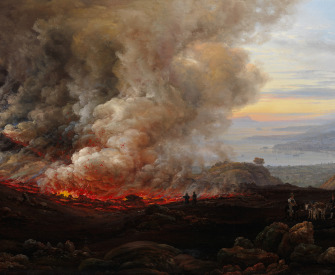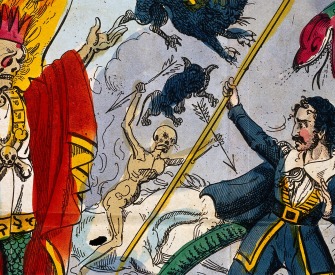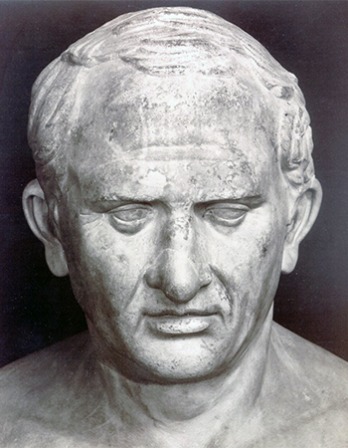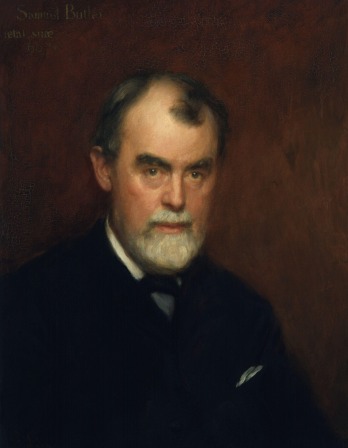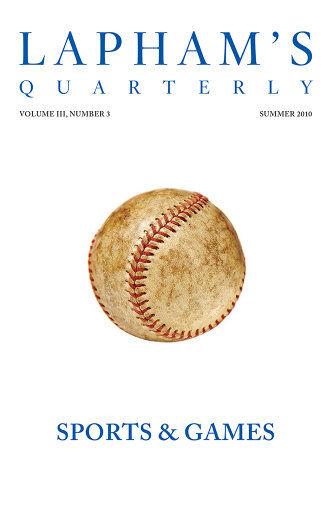For most of us, nighttime dreaming brings us closer to our identities and our power than any activity in the waking world.
—Walter Mosley, 2000The Fading Stars: A Constellation
How the new astronomy obscured the traditional night sky.
By Holly Haworth

Night, by Battista Dossi, 1544. © bpk Bildagentur / Art Resource, NY.
More than four hundred years ago, around 13.8 billion years after the beginning of the universe, in September 1608, a Dutchman from Zeeland came to The Hague announcing he’d invented an instrument “by means of which all things at a very great distance can be seen as if they were nearby.” The prospect was thrilling. European explorers had spent centuries crossing wide oceans in hopes of finding distant lands to claim for their countries, and they were doing so with increased fervor—bringing the resources of faraway places closer to home by establishing trade routes; collapsing cultural distance by eradicating languages, religious practices, ceremonies, myths, and stories; forcing distant others to charade as Europeans with imposed cosmologies and worldviews—since Christopher Columbus had pulled a new world closer, 116 years before the seeing instrument was introduced.
The soldiers who were convened at The Hague that day seized on it as a way to spot enemies on the horizon. They were gathered to talk about independence of the Dutch Republic from Spain’s control, and they paused to consider the arrival of the new contraption. The commander of the Spanish forces said to the commander of the Dutch Republic, “I could no longer be safe, for you will see me from afar.” Ship captains of every European nation would soon have an instrument to spy on one another, to bring distant lands into focus.
News of a “spyglass” reached Galileo Galilei, a professor of mathematics at the University of Padua, in the spring of 1609, when a friend shared with him a description of the invention. Galileo worked out how to make one for himself from a tube and two lenses. But instead of pointing it horizontally to look for enemies, he canted it upward to spy on the faraway night sky. At once, it gave up some deep, dark secrets about the moon, that nearest object to us which had in many cultures been an orbed goddess or the home of one. According to church doctrine and Aristotelian philosophy, it was an immaculate heavenly body—perfectly smooth, perfectly spherical. But what Galileo saw instead were shadows signaling rifts, craters, and mountains. It was not goddess-like but rather a body of rock with topography, an object of scientific study that might be mapped and surveyed.
This moon had already lived ten thousand lives. Hawaiians—not yet “discovered” by Captain James Cook, who would arrive with a telescope in hand in 1778—had thirty different names for it, in accordance with the phases of its cycle, such names as Hilo, “faint thread”; Hoaka, “arch over the door”; Mohalu, “unfold like a flower”; Akua, “god,” for the full moon; and Mauli, meaning “ghost” or “last breath,” for the waning crescent. This same moon was for the Japanese what held the waters of life (silimizi) and the waters of rejuvenation (bakamizi). The same moon that a woman in the Congo 37,000 years ago kept track of by etching notches into a baboon fibula. Moon that for the Yakuts had taken in a young orphan girl as she fetched water with her yoke and pails. Moon that for the Maya a rabbit lived in. Moon that an old man lived in. Moon that had through it all ruled the tides and thus the ocean and all waters of the planet. Moon the cycles by which all cultures always had planted, fished, traveled, harvested, and hunted. Moon that was alive to the faraway eye until men would come to walk on it, imprint its fine untouched dust with their boot soles, plant the American flag to proclaim it—360 years after Galileo first spied it, 4.5 billion years into its existence—desolate, dead, a once mysterious place finally conquered by knowledge. One giant leap for mankind.
In the cloudy spaces of the Milky Way, Galileo saw clusters of stars. In the places that had before looked empty, the dark gulfs of space between stars, he saw even more stars. He saw more stars than had ever been seen. He rushed to publish his findings in Starry Messenger the following year. The mathematician Giovanni Faber, a member of the Italian scientific society Accademia dei Lincei (Academy of the Lynx-Eyed), waxed rhapsodic in response:
Yield Vespucci, and let Columbus yield. Each of them
Holds his way through the unknown sea, it is true.
But you, Galileo, alone gave to the human race the sequence of stars,
New constellations in heaven.
O bold deed, to have penetrated the adamantine ramparts of heaven.
The fired-up language of penetration accompanied the use of the telescope from the beginning, the telescope as a kind of phallus probing the night sky, which had so long been associated with the feminine as a kind of womb, ruled by the moon that was like an egg when full, women’s menstrual cycles waxing and waning with it every twenty-eight days. For Faber it was as if Galileo’s telescope had fertilized the sky and made the new stars in formerly vacuous space.
Encouraged, Galileo kept penetrating the darkness night after night. In the winter of 1610, he wrote a cryptic message to the astronomer Johannes Kepler: “The mother of love emulates the figures of Cynthia.” It was common practice for a scientist to create coded documentation, by way of a dated letter, of an important finding he intended to reveal later to make sure he could prove when the time came that he was due the credit of discovery. The mother of love in Galileo’s code was the planet Venus, and the figures of Cynthia that she emulated were the phases of the moon (Cynthia was another name for the moon-associated Roman goddess Diana, who was shown in many depictions wearing a veil). Galileo had peered into the darkness of the sky chamber and seen the lady Venus undressing. Over the course of the 584 days of her cycle, she slowly slipped off her gown of light and put it back on again.

Custer National Cemetery, Big Horn County, Montana. © Album / Art Resource, NY.
The implication was that Venus orbited the sun, supporting Copernicus’ theory of a sun-centered universe; this would finally bring Galileo before the Roman Inquisition on charges of heresy and land him in the prison of his own house in 1633, where he would remain for the last decade of his life, blind.
But in 1611, the year after publishing Starry Messenger, Galileo was inducted into the Accademia dei Lincei and adopted the signature Galileo Galilei Linceo, “Galileo Galilei the Lynx-Eyed.” The human race had always had the stars, but Galileo the Lynx-Eyed had given them new stars through the instrument that was, at the ceremony of his induction into the academy, named the telescope, from the Greek telescopos, meaning “far looker.” The all-male academy, on its founding in the early seventeenth century, had taken the name of the lynx, the animal thought to have the keenest eyesight at night; its members were expected to “penetrate into the interior of things in order to know the causes and operations of nature, as it is said the lynx does, which sees not only what is outside but what is hidden within.”
With a few adjustments, Galileo had also pointed his telescope down, turning it into a compound microscope. The invention of the telescope and the microscope at nearly the same time allowed scientists to probe the mysteries of the infinitely vast and the infinitely small. Galileo posited that the universe and everything in it was mechanistic, ordered, abiding by rules of law, and that with the new seeing instruments, its parts could be studied, its workings discovered, flies and bees no less well-oiled machines than solar systems and galaxies.
New lands, too: explorers found hidden worlds—continents and islands—within the black oceans, staked their flags into the soil, then set to work mapping the terra incognita. The lands were not unknown to the dark-skinned inhabitants but were for the light-skinned powers until they could gain a carnal knowledge of the place, often raping the women of the American wilderness, a wilderness they called virgin, felling the forests full of shadow so that light could come into the clearings.
These rapacious advances into new territories had their own limits. The cultural historian Marjorie Hope Nicolson wrote that by the early seventeenth century, “the whole world seemed known and mapped,” and a kind of melancholy set in. As the English scholar Robert Burton worked on his Anatomy of Melancholy, finally published in 1621, in which he attempted to dissect the feeling that stemmed from this too-much-knowing, to see it inside and out, Galileo’s seeing machines opened realms to further exploration.
Like Faber, Giambattista Marino, the most famous poet in Italy at the time, compared Galileo to Columbus in his 1623 epic poem, L’Adone. While the latter “cleav[ed] the breast of the ocean, vast and deep,” Galileo explored the heavens and found “new stars and lights once hidden to all men.” Nature, so often spoken of in feminine terms, hid herself from men; that she was vast and deep had become irksome. Knowledge came with light, mystery with darkness. And the darkness goaded men on relentlessly.
With Galileo’s findings, further darkness beckoned to be illuminated. “From Mars and the moon, from Venus and Mercury,” Nicolson wrote, bright lights came shining. There now “appeared a new expanse of space, a vast illimitable ocean without bound.”
Even as Galileo sat under house arrest, unable to travel, he kept his far lookers set up at the windows. In 1638 the English poet John Milton visited him there, in Florence, where he was growing old, his eyes dim.
He showed Milton the sights of heaven, and it was those “thousand thousand stars” that blazed behind Milton’s eyelids when he began to write his epic poem Paradise Lost twenty years later, himself blind by then. What Milton had seen through Galileo’s telescope remained his enduring source of imagination while darkness imbued his greatest period of creativity. He said that the Muse visited him at night and gave him his verses; then in the morning, he would ask to be “milk’d,” dictating his lines to a scribe.
Milton’s drama of the fall of man and humanity’s place in the cosmos plays out against a vast backdrop of interstellar space, sparkling with “innumerable stars.” The epic poem seems at times to settle in with the mystery: “The great Architect / Did wisely to conceal and not divulge / His secrets to be scanned by them who ought / Rather admire.” But more often Milton associates the hidden and the dark places of the cosmos with Satan, the darkness with the unknown, Eve with Satan and thus with darkness. In the darkness, chaos lurks. In the darkness, things are “swallowed up and lost / In the wide womb of uncreated night.” God is light, and goodness dwells in illumination. Milton might well have been writing an epic lament of blindness, while blind to the epic irony that his greatest work was conceived in the dark, that the mesmerizing shimmer of the thousand thousand stars can be seen only in the dark, that the Milky Way is only milky in the dark, that it was only in the darkness he received his Muse’s milk.
The worrisome thing about Galileo’s observations of the phases of Venus, what didn’t sit right with the church, was that if Venus orbited the sun, then the earth and our moon did, too, which meant once and for all that we were not at the center of the universe. If we revolved around a star that was just one of millions of stars in a galaxy, itself one of millions in an illimitable universe, each star a possible sun around which planets might spin, then the earth was, as Adam says in Paradise Lost, “a spot, a grain,” and we were not, perhaps, the apple of God’s eye.
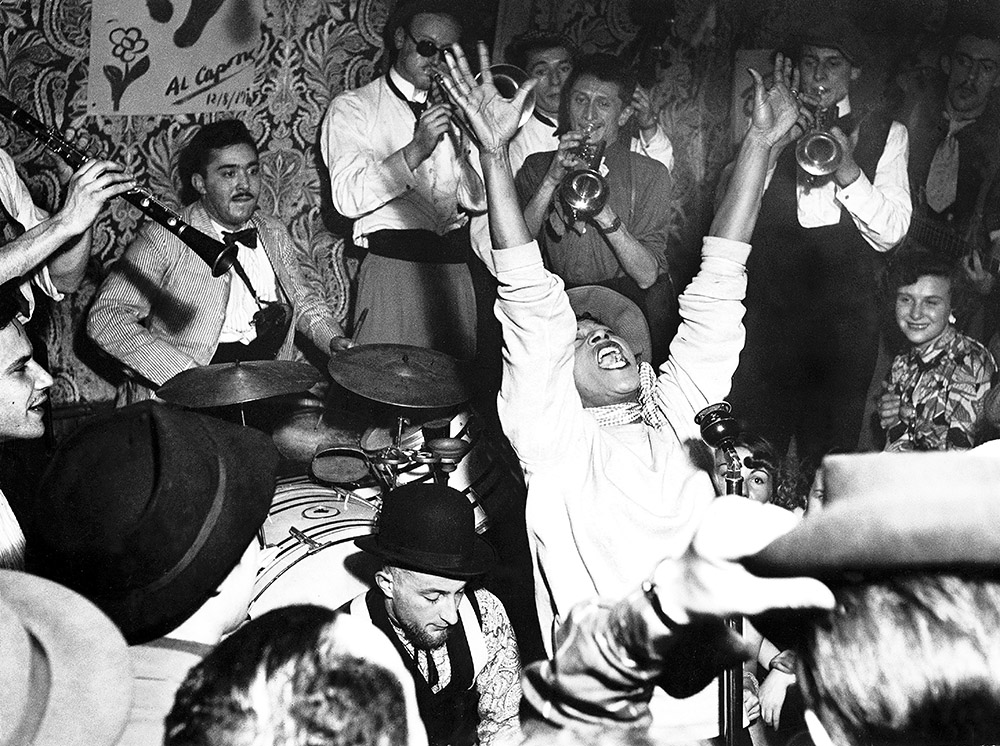
Inez Cavanaugh singing at Club du Vieux Colombier, Paris, 1950. Photograph by Georges Dudognon. © Adoc-photos / Art Resource, NY.
For Europeans who were claiming new Edens all over the globe, it was as if they had been cast out of the garden yet again, into a lonely, darkened cosmos. As if humankind had been banished to this earth that got dark at night, left alone with its fears by God, who dwelled with the angels in eternal light. The “darkness visible,” Milton wrote, “served only to discover sights of woe, / Regions of sorrow, doleful shades, where peace / And rest can never dwell.”
The telescope was credited with lending the light of knowledge to the darkness, gifting sight to the sky that was once obscure. “Much dost thou owe to heaven that grants to thee / the invention of the wondrous instrument,” Marino wrote in L’Adone, “but far more heaven owes to thy superb / device, which makes its beauties manifest.” Making telescopes was a tricky art, a matter of grinding lenses of sufficient quality. Though Galileo the Lynx-Eyed didn’t invent the instrument, he became known for it due to his fine craft—which placed heaven, Marino believed, in the astronomer’s debt, even though heaven had granted Galileo his lenses of glass: glass made of sand that was itself created by the ocean’s pounding, the ocean made to pound by the moon, the tides’ ebb and flow deepened and heightened by the moon’s gravity. Still, for Marino, the moon remained less wondrous than the instrument used to view it.
The fascination spread and expanded; astronomers built longer and longer telescopes. By the time Paradise Lost was published, the far lookers of light had reached heights of thirty feet. By 1670 they were fifty feet tall, and by the end of the century, some were more than three times bigger still. These were used to make detailed maps of the moon, to observe Saturn’s newly discovered rings and satellites, to discover polar ice caps on Mars, to watch the eclipses of Jupiter’s moon Io.
After each night we are emptier: our mysteries and our griefs have leaked away into our dreams.
—E.M. Cioran, 1949Soon astronomical telescopes were becoming “too large to be handled by a single person and too expensive for private individuals,” writes the historian Richard Dunn in The Telescope: A Short History, so state-funded observatories were set up in all the major cities of Europe. Nations competed to build the largest. In 1675, under the aegis of Charles II, England built its Royal Greenwich Observatory, and soon the empire’s first astronomer royal, John Flamsteed, began a forty-year labor to catalogue three thousand points of light in the sky, assigning them numbered designations, applying systematic rigor to the age-old stars. Stars whose cycles were recorded in cuneiform, the first script, on clay tablets in Babylonia. Stars that were hunters who had chased animals into the sky that were also now stars. Stars that to the Greeks were nymphs, nursemaids, and teachers. Stars whose rising, grouped in certain constellations, heralded sailing season for ocean cultures. Stars by which navigators made paths across the sea. Stars that to the Cherokee, who lived in the land I am from, were of the same nature as pine trees. Stars that were young ball-playing boys who didn’t help their mothers gather food for dinner. Stars that danced in a circle. Stars that were sisters. Stars that were brothers. Stars that were ancestors.
The stars of night when night meant darkness. You could still see them then.
In a poem written in 1637, the year before he visited Galileo, Milton wrote of “the stars, / That nature hung in heaven, and filled their lamps / With everlasting oil, to give due light.” This may be the first comparison of the stars to oil lamps, and a hint of what was to come: if humans were stranded in a lonely cosmos, separated from God, why not burn some of the earth’s own oil to light the way through the dark, to make our own earthbound stars.
Having for many years kept curfews that restricted movement through nighttime streets, major cities of Europe and the Americas began enacting laws—at the same time the telescope began its popular rise—requiring public street lighting. In London a 1599 act required every householder to hang a lantern outside at dusk each night from the first of October until the first of March while providing an exception for the shorter nights of summer as well as between the seventh day after the new moon and the second day after the full moon as, according to encyclopedist Johann Georg Krünitz, the “grand light that rules the night lights up the streets sufficiently, and lanterns are superfluous.” The act became more stringent, though, in Milton’s England of 1646, carrying a shilling fine for those who disobeyed. A few decades later, in 1684, an Englishman named Edward Wyndus applied for a patent on the “discovery of a new experiment for the great and durable increase of light by extraordinary glasses and lamps.” With a convex lens, these lights “threw out long rays of light,” the scholar E.S. de Beer later wrote, and “dispelled the unknown terrors of the night.”
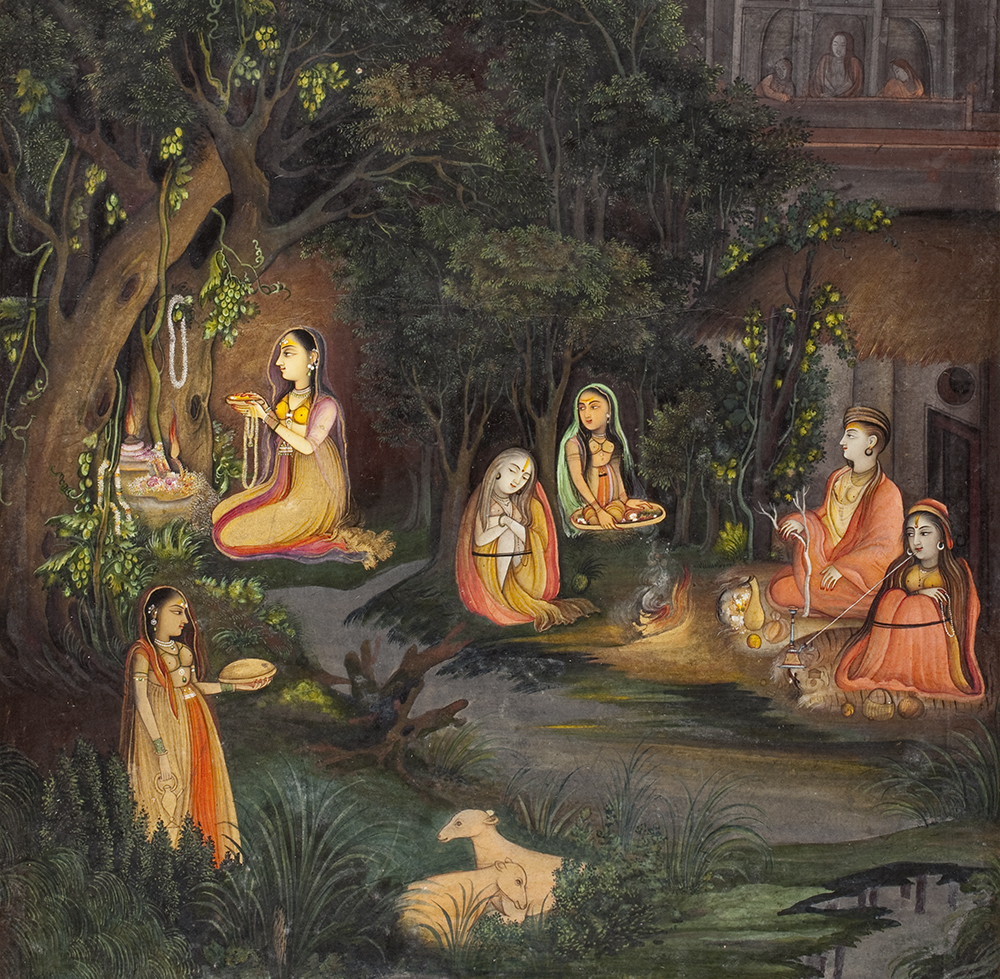
A Princess Visiting a Forest Shrine at Night (detail), attributed to Mir Kalan Khan, c. 1760. The Los Angeles County Museum of Art.
Around the same time, public lighting was introduced in Paris by the city’s first police chief, who was appointed in 1667 by Louis XIV, the Sun King. The lights, called “artificial suns,” became a symbol of the king’s power and of the authority of the police. Under the Sun King—whose personal astronomer tutored Danish astronomer Ole Rømer, who determined the speed of light at the Paris Observatory in 1676—darkness was punishable. Soon there were a thousand lanterns in the city, spaced twenty yards apart.
By 1700 there were more than five thousand lights in Paris. The Sun King died in 1715, but the lights burned on. By 1750 there were eight thousand. Refractors were used to strengthen their power: in 1763 new réverbères were invented to make lanterns shine many times more brightly. In the first volume of his Tableau de Paris, Louis-Sébastien Mercier wrote, “Now the city is extremely brightly lit. The combined force of 1,200 réverbères creates an even, lively, and lasting light.”
The city of London began mandating longer times that lamps should burn, for more of the year, and at shorter distances from one another. It set higher penalties for those who failed to comply. Finally, in 1735 the Court of Common Council decided that lighting should last from sunset to sunrise throughout the year. Prior to the act, it was thought that there had been a thousand lamps in the city lit about 750 hours a year. Afterward, 4,679 lamps were set up, lit more than 5,000 hours each year.
From the Hôtel de Cluny in Paris, the astronomer Charles Messier scanned for diffuse objects in the sky with a telescope. These he would compile in a catalogue of 110 galaxies, nebulae, and star clusters. But city residents were more dazzled by réverbères, hailed for how they “turned night into day.” Paris, center of the Enlightenment, became the City of Light, ville lumière. Poems at the time celebrated the “globes brillantes” and “astres nouveaux,” the new stars. These new stars would outshine the old stars. This globe would be brilliant in the dark universe.
In 1820, two years before the Catholic Church began permitting the teaching of heliocentrism, effectively unbanning Galileo’s Starry Messenger, the British Empire established an observatory in its South African colony, at the Cape of Good Hope. The Cape and its environs were home to the Damara, Xhosa, Zulu, Ndebele, Namaqua, Tlôkwa, Khoikhoi, Tswana, and /Xam, among dozens of other subgroups. Each had its own complex cosmology and relationship with the sun, stars, moon, and planets. Their attendant knowledge, stories, and rituals were soon to fade, but some were recorded by colonists. The nomadic Khoikhoi used the heavenly bodies to reckon their position on the land and guide their nighttime navigation. The Nguni, a grouping that included Xhosa, Zulu, and Ndebele peoples, kept close track of the heavens for the timing of their agricultural practices. For the Namaqua, the appearance of the planet Jupiter in the sky signaled the start of the fruitful season. For the /Xam, the stars gave some of their heart to the people to help them stave off hunger. Many of the Cape cultures divided the year by its moons, each moon with a name that marked seasonal natural phenomena. A record was made of a grass bushman who said the moon is “a thing which knows things; for it sees things which will come to pass. It is the one who knows them, things which we do not know.” In one /Xam story condensed by a colonist, “the moon angers the sun so much that the sun stabs the moon with its knife (rays) until the moon is reduced to a backbone. At this point, the sun spares the little piece, which goes home to grow back to its full size, only to begin the cycle anew.” The telling of such stories created an intense intimacy with the night sky.
I’ve dreamed enough to have a drink.
—François Rabelais, 1546British astronomers sent to track the heavens of the southern hemisphere at the Cape observatory loathed and feared these dark-skinned storytelling natives. They sent letters of bitter complaint home about both the “dirty, black, flea-y” inhabitants and the snakes that lurked in the grass. They promoted the observatory as a beacon of light and knowledge in a land that they would come to call the Dark Continent.
John Herschel—son of astronomer William Herschel, who had first spotted Uranus and built a telescope in England so enormous that it served as an emblem of the Royal Astronomical Society—came to the Cape and set up a private observatory in 1834. His goal was to catalogue the stars and constellations and give them “rational” names. In a letter to the royal astronomer, Thomas Maclear, who resided at the official Cape observatory just a few miles away, he insisted that none of the natives’ names for the stars be preserved. Maclear wrote back, “All the practical astronomers will back you in expunging the heterogeneous jumble of birds, beasts, men, and things…that appear ridiculous in astronomical research.”
This expungement was part of a global shift in the way the night sky would come to be viewed, not as particular to the individual cultures in whose lives they played both practical and mythical parts but rather, as the historian Elizabeth Green Musselman writes, a “celestial blanket [that] covered the globe in one fabric.” The blanket of stars heralded “a one-world empire,” and those with the telescopes named each point of light and the constellations they formed when strung together, overlaying the vast kaleidoscope of names and stories that the heavenly bodies held for peoples in every tiny portion of the globe. The International Astronomical Union would eventually standardize the constellations with official names in order to avoid what one modern astronomer called “a chaotic situation.”
The British made a striking observation about the bush people: their eyes, wrote one colonist, were “little inferior in optical power to small telescopes.” Another said of them that “the eye operates with a precision and force, which a person who has never witnessed the like would scarcely be disposed to credit…They will often discern with distinctness what others require a telescope to distinguish.” For these native inhabitants with their telescopic vision, the stars were already close; in their eyes, the astronomers who used long tubes and lenses to view the stars but did not pattern their lives around them or tell stories of them must have seemed very far from the twinkling lights of the heavens.

Inez Cavanaugh singing at Club du Vieux Colombier, Paris, 1950. Photograph by Georges Dudognon. © Adoc-photos / Art Resource, NY.
The colonial stargazers had come far from home to get closer to them, and they beamed with enthusiasm in their letters about the skies of southern Africa, which were crystal clear. Back home the frenzy for lighting up the night had taken its toll on visibility. In 1805 a cotton mill in Manchester became the first factory to be illuminated with gaslights at night; two years later came gaslights through London streets, followed by the first electric lamps. Industry now continued into the night, and the skies back in Britain were smogged by coal and washed with lights. The heavens in Europe had already receded.
But at the Cape, they seemed very near. One colonist wrote in a letter home:
Many of the most beautiful and interesting phenomena of the heavens are here more beautiful and interesting, from the pure and gentle transparency of the atmosphere through which we gaze at them. A spectator accustomed to the hazy skies of the north turns oft with untired gladness to the distinct and vivid objects of our horizon, the hues and changes of the twilight, or the brilliancy of the azure noon. The nearer to us of the heavenly bodies partake of this distinctness; the setting planets blaze like masses of flame on the sea; the moon…[is] very dissimilar to its vapory and languid disk in the English sky.
The John Herschel who wanted to rid the stars of the local inhabitants’ stories of them wrote home to a fellow astronomer, “I cannot help believing that we are nearer the stars here.” He could not help believing it, although as a rational scientist who had taken measurements of the whole earth, he knew that couldn’t be true. And yet.
In Egyptian myth the night sky is a woman’s body. She arches her back, stretches out over the land. In some ancient tellings, she swallows the sun god Ra each night and births him in the morning. She is the vault of the sky, the mistress of all, the holder of souls, the producer of all heavenly bodies. It was she whom astronomers around the world spied on, mapped, catalogued, claimed as their own discovery.
More than a decade before the British observatory was built on the Cape, a Khoikhoi woman was kidnapped after her father and husband were killed in a Dutch extermination raid. She became a slave in Cape Town, then ended up in the hands of an English doctor, who took her to the bright Piccadilly Circus stage in London, where she was exhibited as a dark specimen of the hidden interior of an unmapped continent. The Khoikhoi were called Hottentots by colonists who could not understand their language, a subtle system of clicks and clacks, and the woman would become known as the Hottentot Venus. Her black skin and her anatomy—particularly her “oversized” buttocks and enlarged labia—were a spectacle, material for study by scientists who wanted to classify the inferiority of blackness. They were given special invitation to come see her. In her first performance, she was poked and prodded by fingers and the pointed tips of parasols and canes.
Later she was sold to an animal trainer, who took her to Paris, City of Light. Onstage, she was illuminated so that her audience could gawk in wonderment—as a saying went in her culture, “like a lion looking at the moon.” When she died in 1815 of an inflammatory disease, at the age of twenty-six, leading European scientist Georges Cuvier, then a professor of comparative anatomy at the Museum of Natural History, cut apart her genitalia, that most mysterious, darkest part of her dark body, examined them under a microscope, then put them in a jar for public display at the Museum of Man.
By the time Herschel examined the night’s black body with his telescope at the Cape observatory, the Khoikhoi culture had already disintegrated. A school friend wrote Herschel a poem the year he arrived: “If Herschel should find a new star at the Cape,” it read, “He will salt the star’s tail to prevent its escape / And call it ‘The Hottentot Venus.’ ” For in 1834 she had already burned out as a star attraction in Europe, and the folds of her labia had been examined in full—feminine darkness dissected and exposed under science’s laboratory lights.
If this story that begins with the invention of the telescope is an origin story, of the birth of modern astronomy—the science that has uncovered more secrets of the universe than we’d ever known were possible—it is also the story of the death of the night sky and whatever enveloping mystery it once might have held us within, the exit from the dark womb of our own origins.
Perhaps it’s some grand cosmic prank that the story of our advancing knowledge of the universe’s darkness is also the story of our retreat from that darkness, our enshrouding ourselves in a haze of lights of our own making. Or perhaps these are only moments in history that collided and will, in the end—though when will it ever end, the universe and all this birthing and dying, all these collisions?—be revealed as only so many plot points pulled together into a constellation in what is otherwise a chaos of stardust assembling and disassembling and reassembling into strange clusters of matter. Like lynx, for instance, who can see in the dark, or like what’s known as the twilight zone of the ocean, to which marine biologist Sylvia Earle traveled in 1979 and saw in that remote darkness “the flash and sparkle and glow of bioluminescent creatures,” such as corals that emitted “little rings of blue fire” when she touched them.
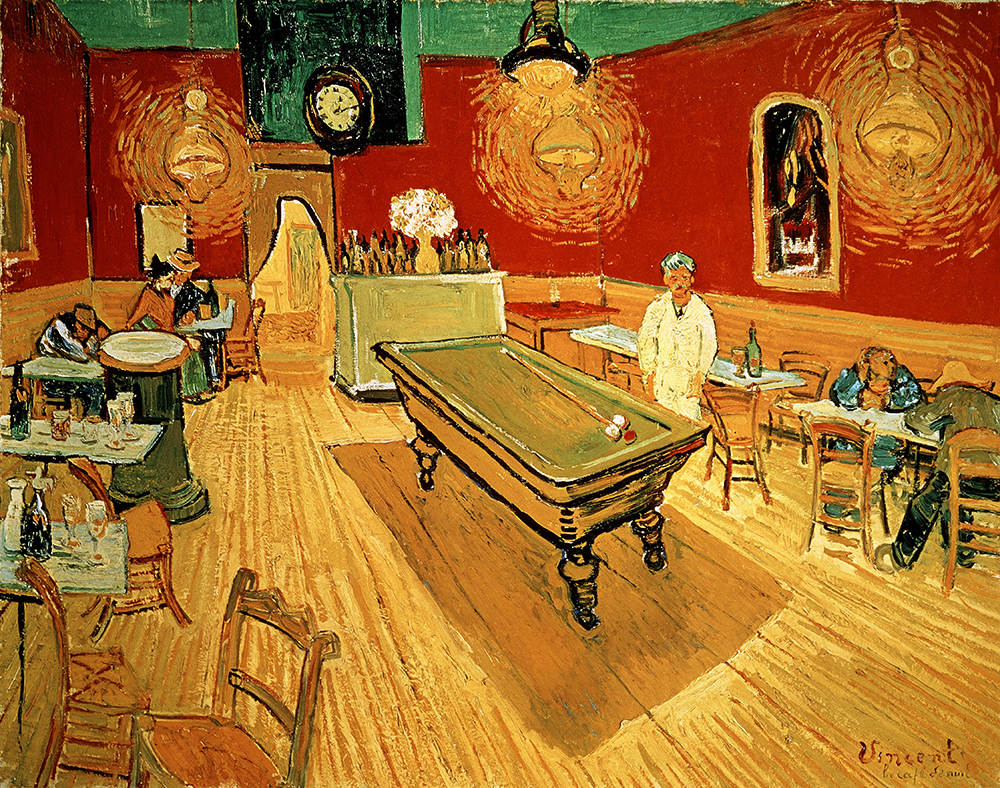
The Night Café, by Vincent van Gogh, 1888. © Album / Art Resource, NY.
It matters, though, surely, that only 1 percent of Europeans and Americans can still clearly see the Milky Way at night, that only 20 percent of terrestrial Earth now has true darkness. Italy, home to Galileo, who gave us the stars, is now considered to be among the most light-polluted—which is to say starless—countries. We know this because of satellites we have launched, our astronomical technology now being used to scrutinize our own bright globe in this self-obsessed age, the satellites’ orbits like the universe’s longest selfie sticks.
Because of the telescope, we now know that the universe is expanding, and the black gulfs of space between celestial objects are growing ever wider—the astronomer Edwin Hubble published this observation in 1929. The story of the far looker, then, is in part the story of how it was discovered that everything is getting farther away from us.
Most astrophysicists now think that the bulk of the matter in the universe—85 percent—is dark matter. This is a hypothesized type of matter, only implied by gravitational effects but invisible to the electromagnetic spectrum, not interacting with light at all. Because of the telescope, we now know that our galaxy’s center is a supermassive black hole from which no light can escape. In other words, this whole thing we call the “cosmos”—a short simple name to contain the vastest, deepest, most ineffable of mysteries—is mostly darkness: invisible dark matter and dark energy, unmappable and uncrossable black holes, an unknown. No light can fully penetrate it. And yet the darkness goads men on. Lynx have largely disappeared worldwide, and the vertical migrations of bioluminescent phytoplankton—the largest migration in the world—are disrupted by ships beaming lights as they cleave the breasts of the black oceans.
